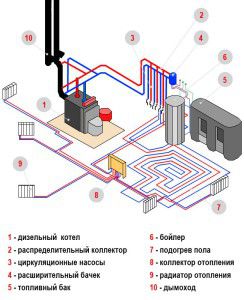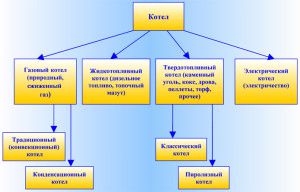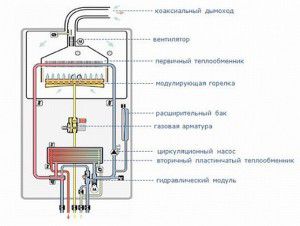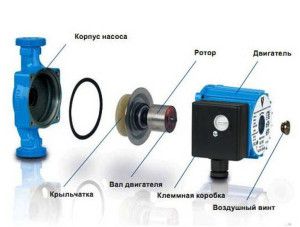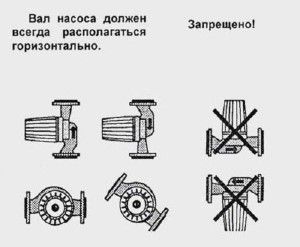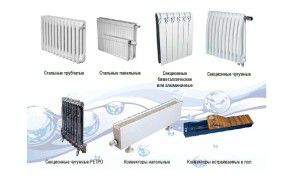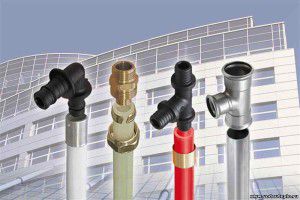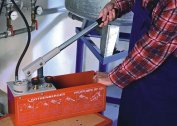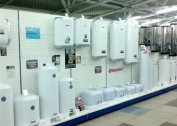The optimal configuration of the heating system depends on many factors. The coherence of the work of all its elements is a guarantee of a consistently high coefficient of efficiency and operational reliability. Therefore, first you need to solve the question - how to choose the right heating system: boilers, pumps, radiators, pipes.
Overview of the main components of heating
The most difficult in the design and selection of components is an autonomous water heat supply at home. This system consists of several important elements, without which its operation is impossible.
Before choosing the right boiler for heating a house, you need to consider all the other components of an autonomous heat supply. The essence of their work is to heat the coolant, transferring it through pipes to radiators. It is through them that the exchange of thermal energy between hot water and indoor air takes place.
But how to choose an electric heating boiler for a similar circuit. Consider the functional features of the elements of heat supply of an autonomous type:
- The main function of boilers - increase the temperature of the coolant (water, antifreeze) to the required level. The energy from the combustion chamber of the fuel (or electric heating elements) is transmitted using heat exchangers. Therefore, it is important to know how to choose an electric boiler for heating;
- Pipelines. Through them, water with high temperature enters the radiators;
- Batteries. They are heat exchangers for transferring accumulated thermal energy to indoor air. This is done through convection processes;
- Circulation pumps designed to increase the flow rate of the coolant along the highways. With their help, a uniform distribution of heat through radiators and pipes is carried out. Before choosing a pump for heating - you must first calculate the parameters of the future system.
Therefore, before choosing a circulation pump for heating or any other element, it is necessary that their operational and technical characteristics are compatible with the main parameters of the future system.
For the calculation of heating, it is recommended to use special software systems. Manual calculation can lead to errors, which will directly affect the performance and reliability of the heat supply.
Choosing a boiler for autonomous heat supply
When starting to complete an autonomous heat supply, special attention should be paid to the boiler. This device is the key to organizing the entire system. Since it is impossible to choose a gas heating boiler without basic knowledge of its properties, you need to at least superficially study its characteristics.
They reflect not only its functional, but also operational qualities. In addition, each type of boiler has its own requirements for installation and further technology for the prevention of breakdowns.
The discrepancy between the calculated and actual characteristics of the boiler should not be more than 5%. You can buy a model with a small margin of power, but not less than required.
Type of fuel used in the heating boiler
One of the determining parameters is the type of energy carrier. The easiest way is to choose an electric boiler for heating the house - for this you only need to connect the device correctly and make it the correct wiring.
Currently, there are 4 main types of energy carrier that affect the proper selection of a boiler for heating a house:
- Gas. The most common, since it differs in affordable cost and a large amount of thermal energy during combustion. In heating systems, you can use the main or liquefied (balloon) gas. However, before selecting a gas heating boiler, you need to determine the company for its installation. Doing it yourself without permits is prohibited;
- Solid and liquid fuels - firewood, coal, diesel. Correctly choosing a boiler for heating a house of this type is possible only if there are cheap energy sources. Also, the choice is forced if there is no gas line;
- Electric power. These are one of the most optimal types of energy for organizing heat supply of a small house or apartment. For the selection of an electric heating boiler, its normal power is important. The common house network must be designed for such high loads.
Until recently, it was difficult to choose an effective electric boiler for heating. This was due to a relatively low efficiency factor. However, the emergence of new water heating elements (TENs) and the use of fundamentally different methods of increasing the temperature of the coolant using electricity again made boilers of this type in demand.
When choosing a gas boiler, you need to pay attention to its reconstruction for operation on liquefied or natural gas. Thus, it is possible to ensure uninterrupted functioning of the heat supply even when the gas line is switched off.
Operational features of a heating boiler
The defining characteristics of a heating boiler include its rated power. It determines the maximum degree of heating of water in the pipes and, as a result, compliance with the thermal regime of the entire heat supply. This parameter is calculated before the choice of an electric heating boiler or its solid fuel (gas) analogue.
Modern boiler models are designed not only for heating, but also for hot water supply. For this, a secondary heat exchange circuit is provided in their design, in which the water is heated, which is then used for domestic purposes.
In addition, when choosing an electric heating boiler, you must pay attention to the following points:
- Equipment. Some models may include a circulation pump, expansion tank and safety group;
- Work adjustment system. For solid fuel boilers, it is the simplest - a decrease or increase in the intensity of fuel combustion occurs by restricting the flow of fresh air. In electric or gas models, this function is performed by electronic devices;
- Mounting method - wall or floor. The first option is acceptable if you are choosing an electric boiler for installation in the kitchen. It will take a little space and harmoniously fit into the overall interior of the room.
These are just general recommendations for choosing a heating boiler. The subtleties and nuances of its required technical (operational) characteristics depend on the calculated parameters of the heat supply system.
Before purchasing a boiler model, you need to find out the location of the nearest service of the manufacturer or its official representative. This will help to quickly resolve the issue in the event of equipment failure.
Parameters for the selection of pumps and expansion tanks for heat supply
The installation of a circulation pump is necessary for closed heating systems. With it, the speed of movement of hot water increases. This leads to a uniform temperature distribution - the coolant does not have time to cool down, reaching the latter in the system of radiators and batteries.
How to choose the right pump for the heating system, if the basic design requirements are known? First you need to determine the type of pumping equipment. Depending on the cooling method of the electric motor, the pumps may be with a wet or dry rotor. The former emit significantly less noise during operation. Therefore, when choosing pumps for heating, the choice stops on these models.
In addition, it is necessary to take into account the main operational and technical parameters:
- Performance. This characteristic determines the amount of water passing per unit of time - m³ / hour;
- The size of the connected nozzles. In addition to performance, you need to choose the right pump for the heating system for its correct connection. The large difference between the diameters of the nozzles in the line and the pump can lead to an increase in hydraulic resistance;
- Pressure. This value will determine the maximum height of the water column during pump operation.
Also, when choosing a circulation pump for a heating system, you need to pay attention to how to install it.
In addition, for the correct pump selection for the heating system, the maximum permissible pressure in the pipes must be taken into account. It ranges from 10 to 24 bar. It is important that this characteristic is not lower than the maximum design value for the system.
One of the secondary parameters when choosing a pump for heat supply is the rated current consumption. On average, it ranges from 0.05 to 0.1 A / hour. However, to ensure uninterrupted operation of the equipment in the event of a power outage, it is recommended to additionally purchase an emergency power supply.
Along with this device, the question should be solved - how to choose an expansion tank for heating. It is designed to compensate for excessive pressure in the system. The heat supply scheme affects the choice of an expansion tank for heating:
- Open type. It is installed in open gravitational heating circuits;
- Closed (membrane) type. A must-have item for completing systems with forced water circulation.
When choosing expansion tanks, the volume of coolant in the system must be taken into account. For membrane-type models, the device operation parameters (maximum and nominal pressure) must be verified with those in the design scheme.
It is best to purchase a pump whose power will be 10-15% more than the calculated one. In this way, you can increase the heating area of the house without replacing this component with a more productive one.
The choice of radiators and radiators
The transfer of heat from hot water to indoor air occurs through the surface of the radiators. They are installed in every room of the house where it is necessary to maintain a comfortable temperature level.
When deciding how to choose heating radiators for a private house, you need to be guided by several rules. This heat supply device should ensure optimal heating of the air in the room and at the same time have minimal values of heat transfer resistance. How to choose a heating radiator, taking into account these requirements? You need to decide on the material for making the batteries. Currently, the following are used for their production:
- Cast iron. It has a high energy intensity. Those. after cooling the surface of the cast-iron batteries will be warm for some time. However, the reverse process will also be observed - a long heating time of the radiator when heating starts;
- Aluminum. The optimal choice as heating radiators for the home. This material is characterized by the best indicator of thermal conductivity. But there are several significant drawbacks - susceptible to pressure drops, you can not use antifreeze;
- Metal. Most of the assortment is intended for the economy segment of the market. Despite its light weight and good technical characteristics, the metal rusts relatively quickly. To avoid this, manufacturers coat the surface of the radiators with protective powder paint;
- Bimetal radiators. They combine the mechanical strength of metal and the heat-conducting qualities of aluminum. Despite the high cost, bimetallic models are the right choice as heating radiators.
The determining technical parameter of batteries is their rated power - W. It depends on the temperature of the heating system. Manufacturers most often indicate power for 70/55 mode. It also affects the size of the device and the center distance between the connection pipes.
The choice of pipes for heating
How to choose pipes for heating and additional elements to them? Highways are necessary for the delivery of coolant to radiators. At the same time, they must withstand the maximum pressure temperature during the operation of the heating system.
For the correct choice of heating pipes, their qualities and characteristics should be taken into account:
- Production material - steel, plastic, copper. For the organization of heat supply in a private house or apartment recently installed polymer pipelines. However, they will not work if the level of heating of the coolant exceeds + 90 ° C;
- Pipe diameter. Estimated value, depending on the pressure indicators, the required speed of water circulation and heat transfer of the entire system;
- The complexity of installation. Least of all effort will be required to install polymer pipes.
Along with the choice of pipes and other heating components, no less attention should be paid to the safety and control groups of the entire system. Their design and functionality depend on the selected heat supply scheme.
In the video material, you can familiarize yourself with the parameters for choosing pipes for heating:
